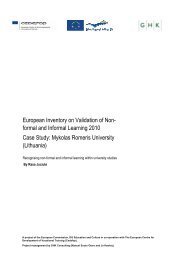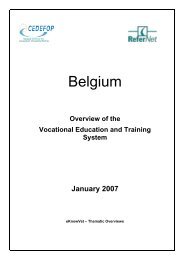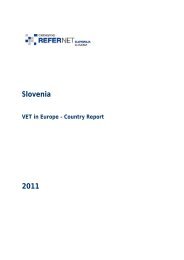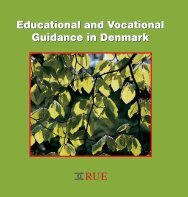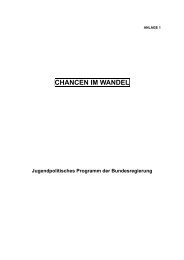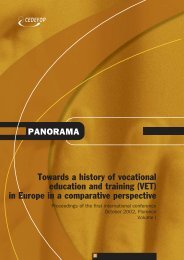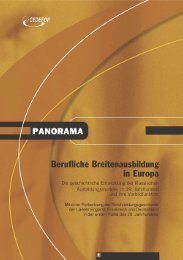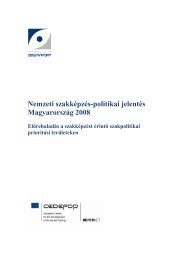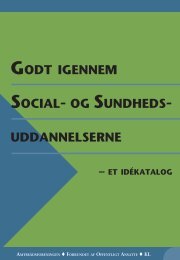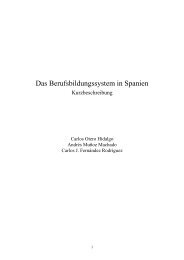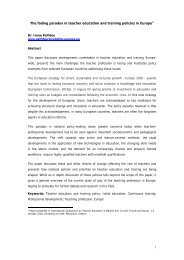PROFF – Professionalisation of VET teachers for the future - Europa
PROFF – Professionalisation of VET teachers for the future - Europa
PROFF – Professionalisation of VET teachers for the future - Europa
Create successful ePaper yourself
Turn your PDF publications into a flip-book with our unique Google optimized e-Paper software.
enterprise. In <strong>the</strong> new setting, <strong>the</strong>ory has to be more tightly integrated with practice than in <strong>the</strong>past. Above all, <strong>teachers</strong> and trainers have to feel <strong>the</strong>y are taking part in <strong>the</strong> training process.Often <strong>the</strong> push to adopt (and teach) new teaching practices has come not from <strong>teachers</strong><strong>the</strong>mselves but from new legislation or management. It is essential, <strong>the</strong>re<strong>for</strong>e, that <strong>teachers</strong>develop a sense <strong>of</strong> ‘ownership’, working to make <strong>the</strong> new techniques <strong>the</strong>ir own.A review <strong>of</strong> <strong>the</strong> programmes studied shows several clear transnational trends:• most programmes adopt a ‘dualistic’ approach, alternating on-<strong>the</strong>-job learning with<strong>the</strong>ory or <strong>the</strong>ory with work in <strong>the</strong> teacher’s own classroom, mixing in<strong>for</strong>mal and <strong>for</strong>mallearning. While this approach is not new, recent programmes have been increasinglyeffective in integrating <strong>the</strong>ory and practice. Alternating practice with <strong>the</strong>ory provides newways <strong>of</strong> communicating: between teacher educators (including supervisors, externalconsultants, or whoever may be responsible <strong>for</strong> training) and participants;• many programmes adopt a flexible, modular approach to curricular planning,personalising teaching to meet <strong>the</strong> needs <strong>of</strong> <strong>teachers</strong> and trainers with different needs anddifferent backgrounds;• several programmes favour a ‘bottom-up approach’ which encourages <strong>teachers</strong> to reflecton <strong>the</strong>ir teaching practices, express <strong>the</strong>ir skill needs and take part in designing andassessing training to meet those needs. This avoids <strong>the</strong> risk that a more academicapproach or an approach not based on daily practice and on <strong>teachers</strong>’ own experiencemight provoke resistance to change. In programmes based on this strategy, teachertraining no longer follows a fixed lecture-based curriculum but adapts from day to day, inline with participants’ daily practices;• in some cases (e.g. in <strong>the</strong> Finnish Tukeva programme) teacher participation is encouragedby creating ‘study circles’ and ‘experience exchange groups’ involving staff fromdifferent departments and institutions. This enables participants to learn about practicesin o<strong>the</strong>r schools or in o<strong>the</strong>r parts <strong>of</strong> <strong>the</strong> <strong>VET</strong> system, <strong>the</strong>reby gaining a new perspective <strong>–</strong>and a stimulus <strong>for</strong> reflection <strong>–</strong> on <strong>the</strong>ir own practices;• ICT (websites, web-conferencing) <strong>of</strong>ten provides a powerful tool <strong>for</strong> encouragingexchanges <strong>of</strong> views among participants and <strong>the</strong>ir <strong>teachers</strong>. Use <strong>of</strong> <strong>the</strong>se tools is especiallyeffective when available <strong>for</strong> <strong>the</strong> duration <strong>of</strong> training. In some cases (e.g. <strong>the</strong> Italian HEPprogramme and <strong>the</strong> Finnish Tukeva programme), part <strong>of</strong> <strong>the</strong> programme is delivered indistance learning mode (i.e. via ICT).The programmes studied varied remarkably. Some, such as TOKE and HEP, were very broadin scope with part-time participants taking one to two years to complete <strong>the</strong>ir studies. Bothprogrammes required participants to invest time outside <strong>the</strong> classroom. TOKE requiredstudents to write reports and analyses; HEP involved <strong>the</strong>m in study visits.O<strong>the</strong>r programmes (such as Telkkä) were much shorter. Telkkä participants worked full-timein an enterprise <strong>for</strong> just two months (although this was preceded by a seminar and independentwork preparing <strong>for</strong> <strong>the</strong> seminar).27



